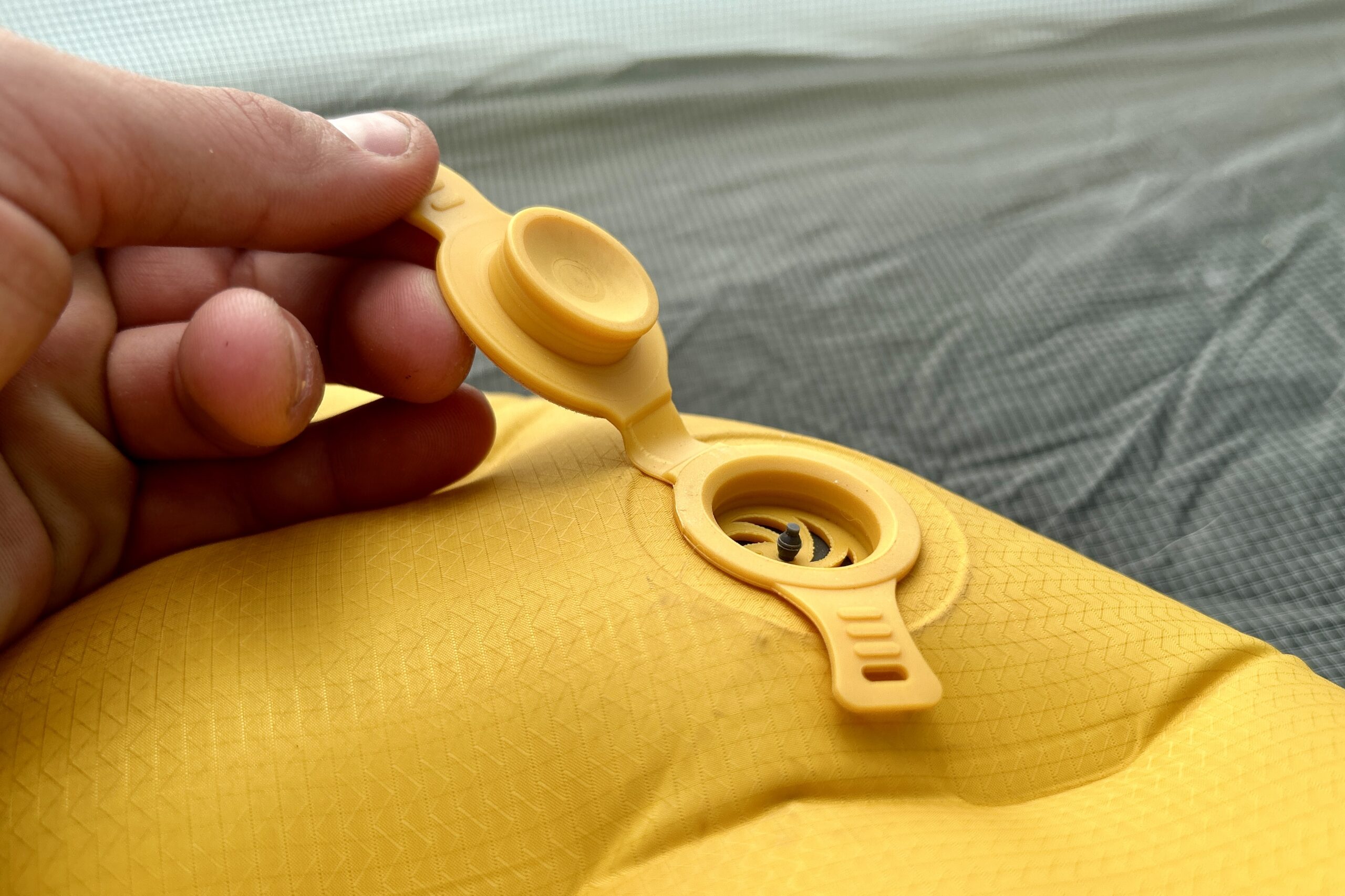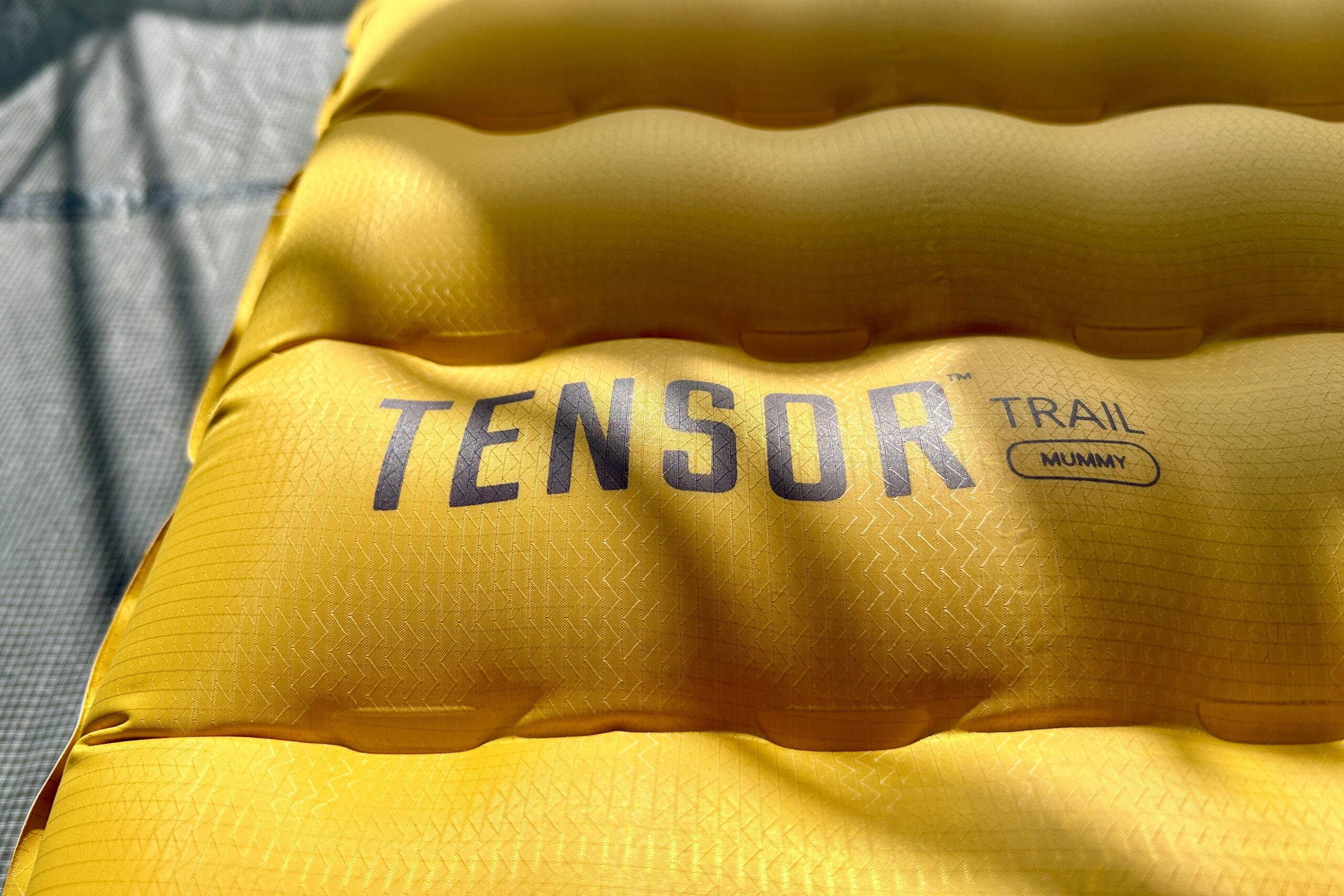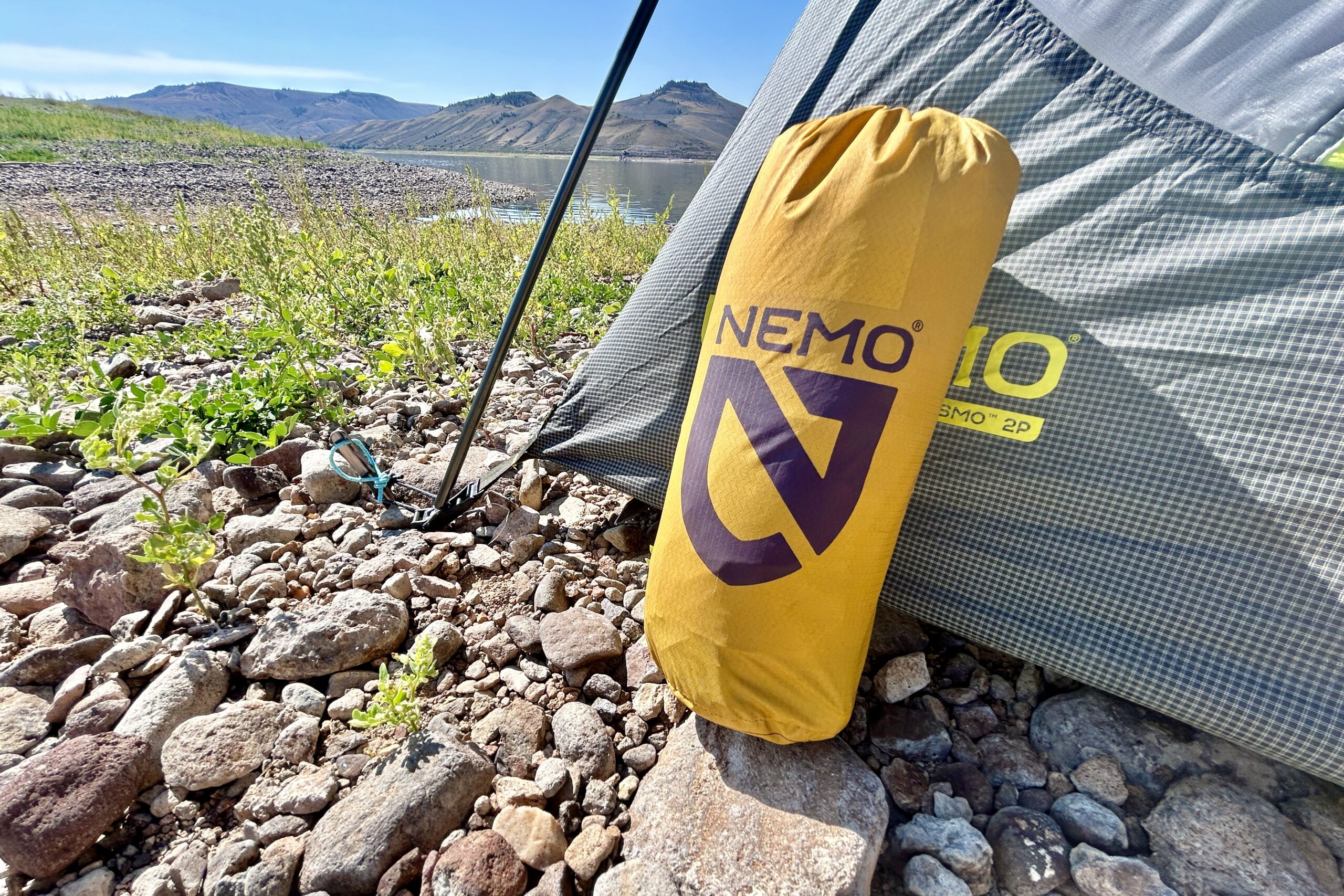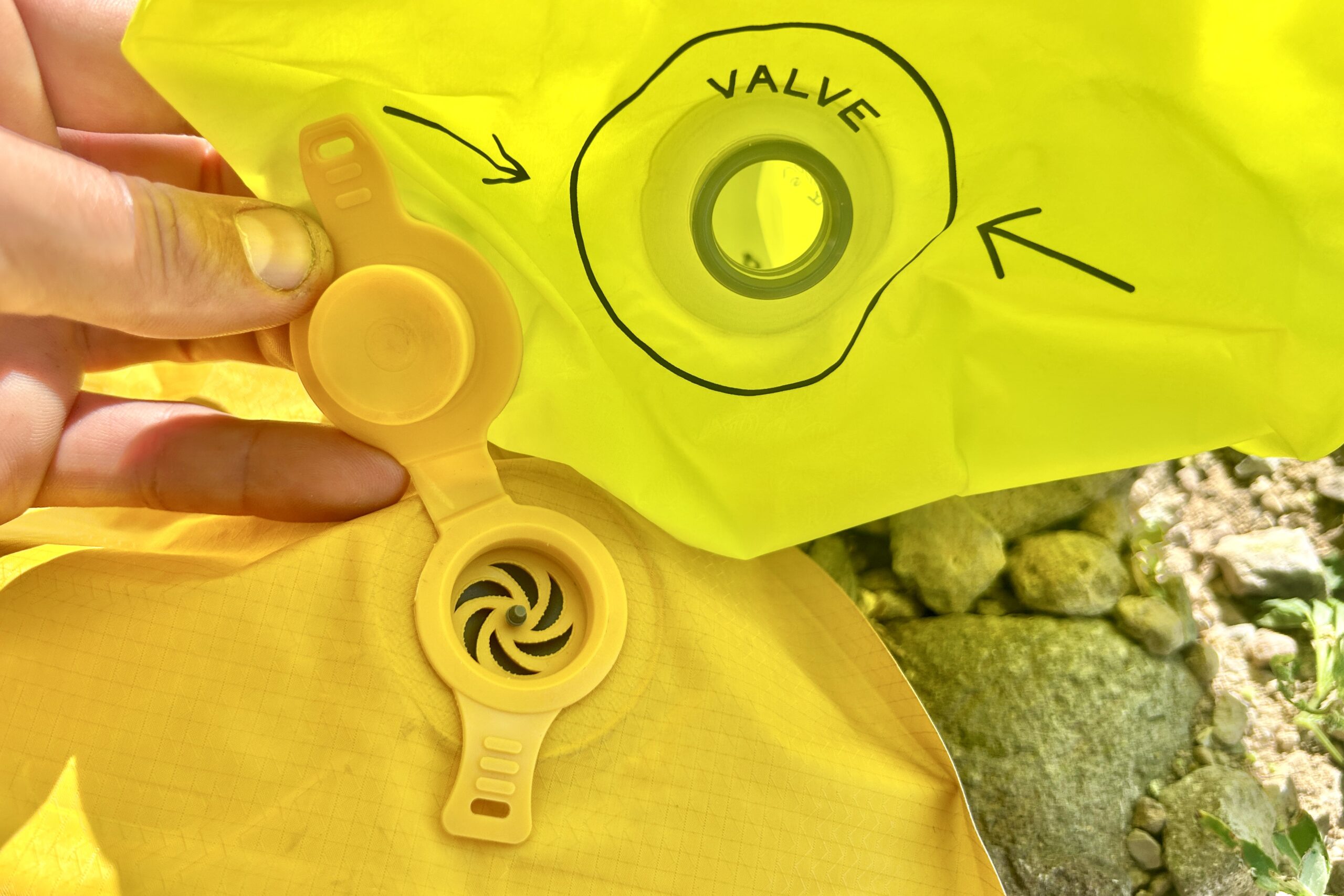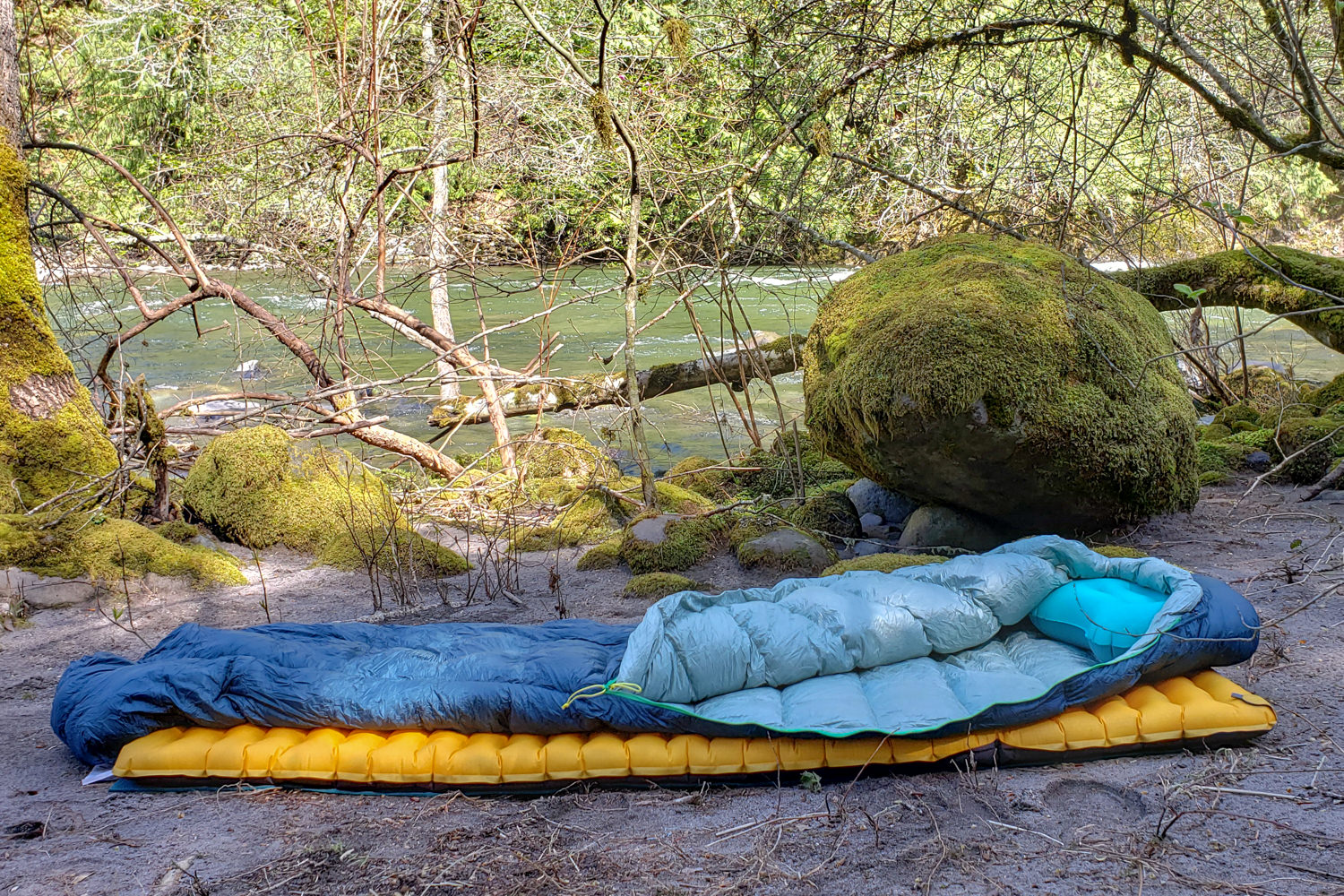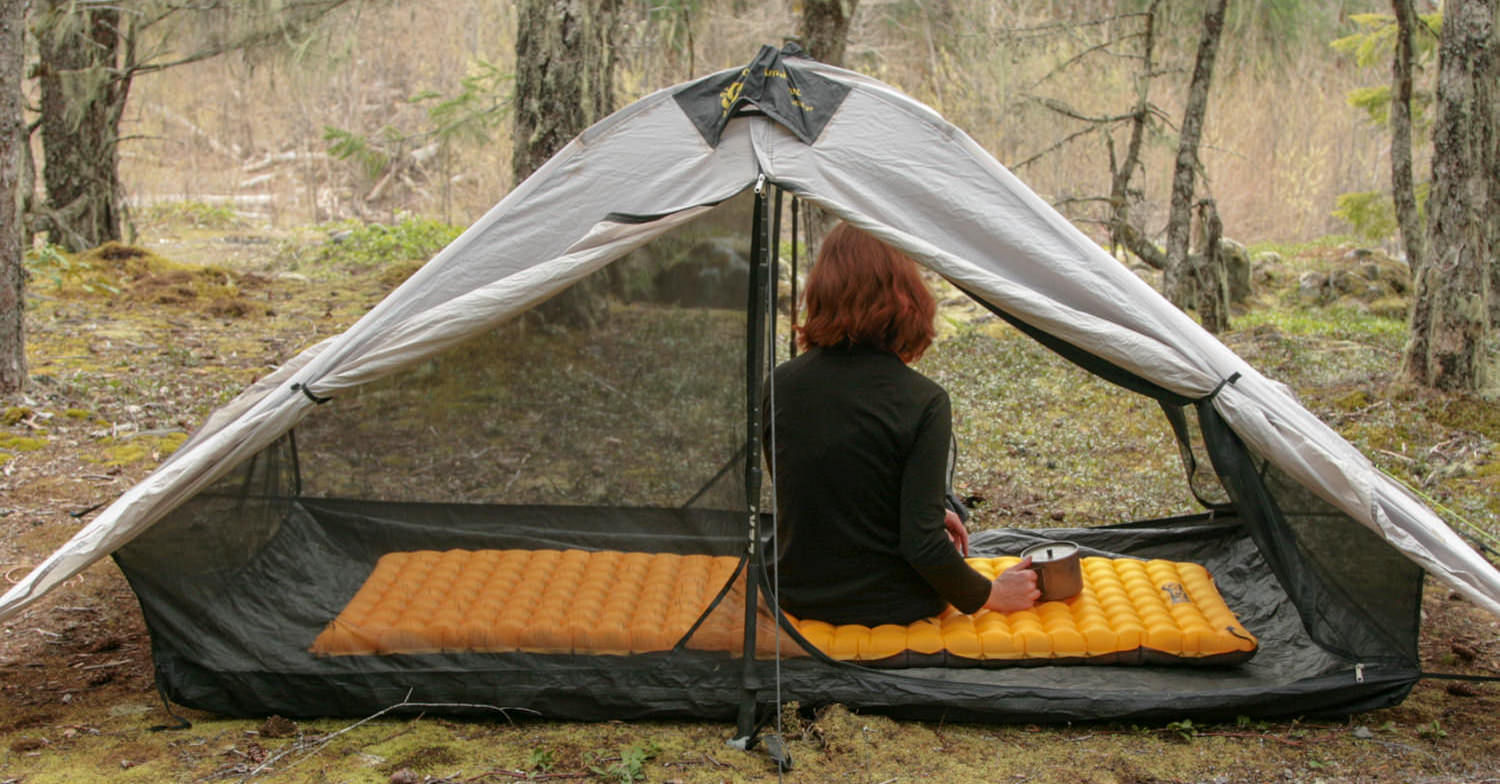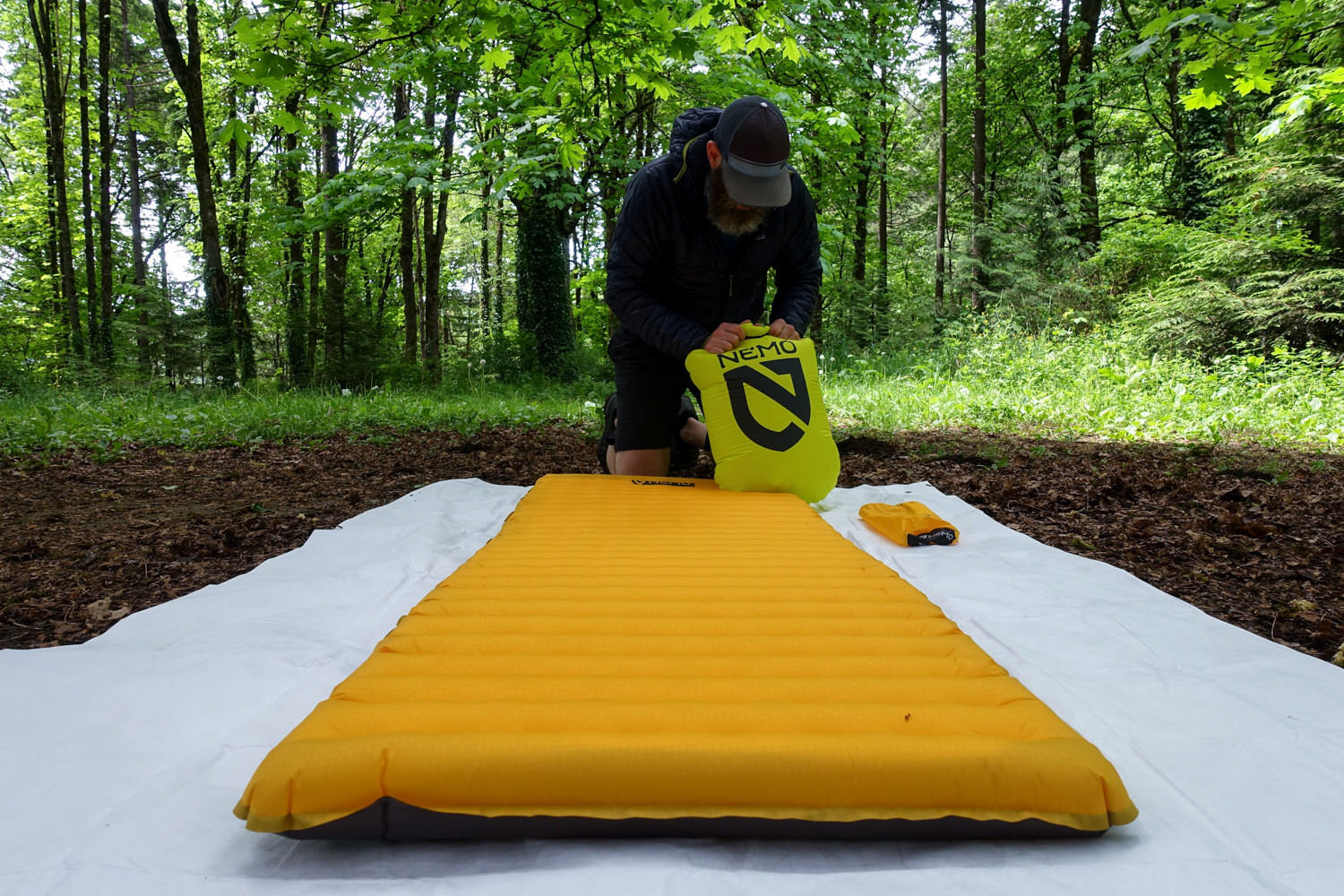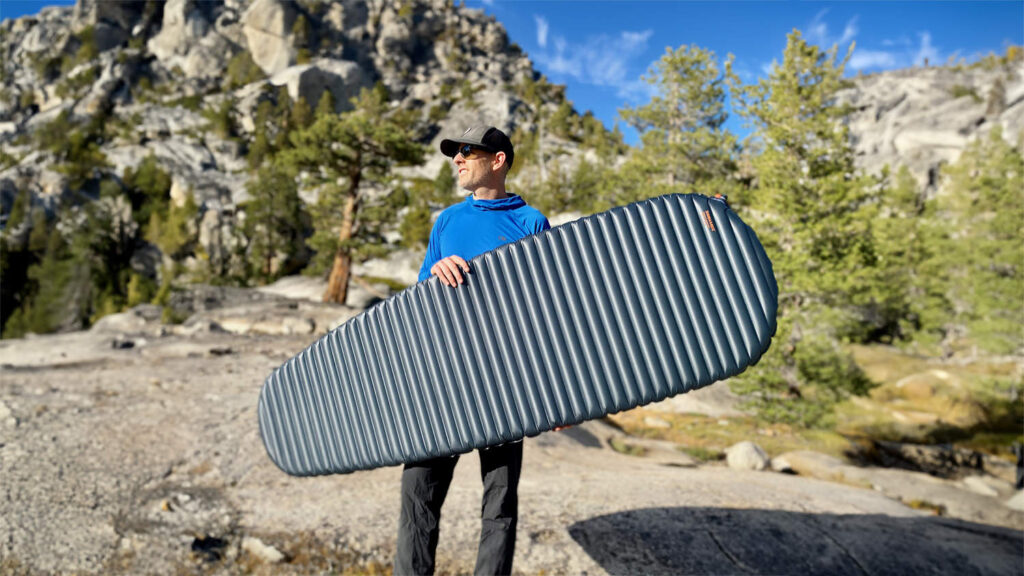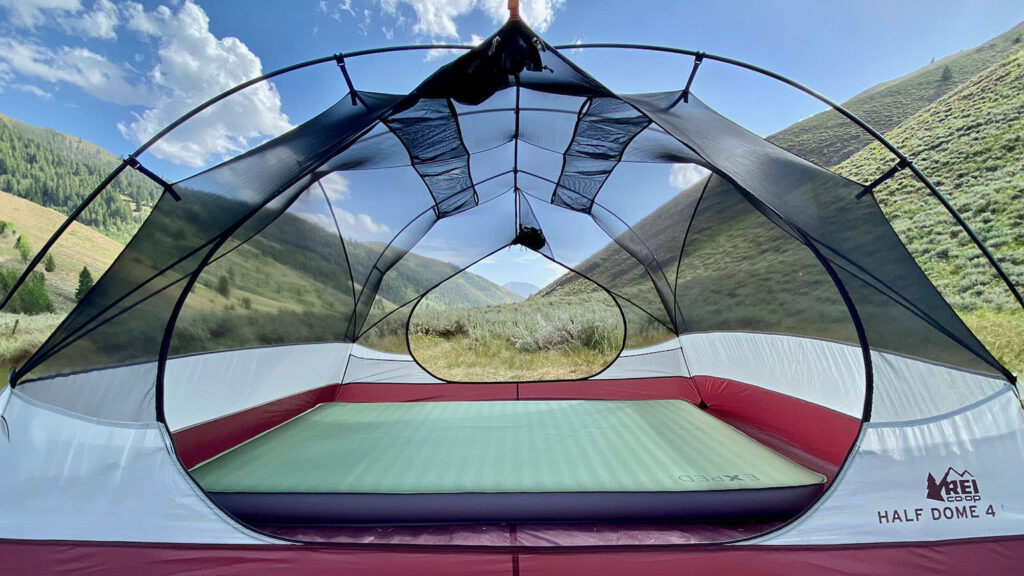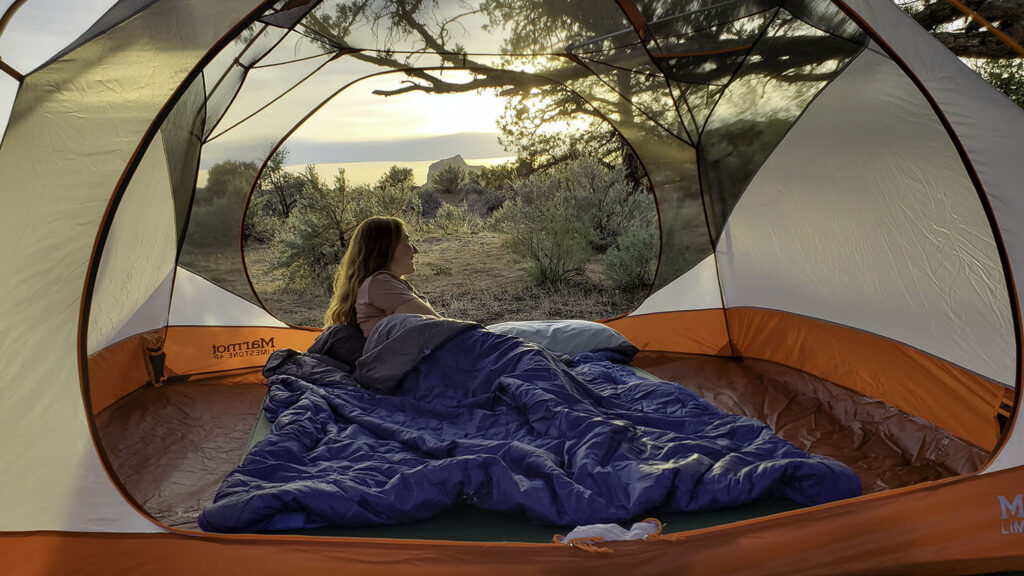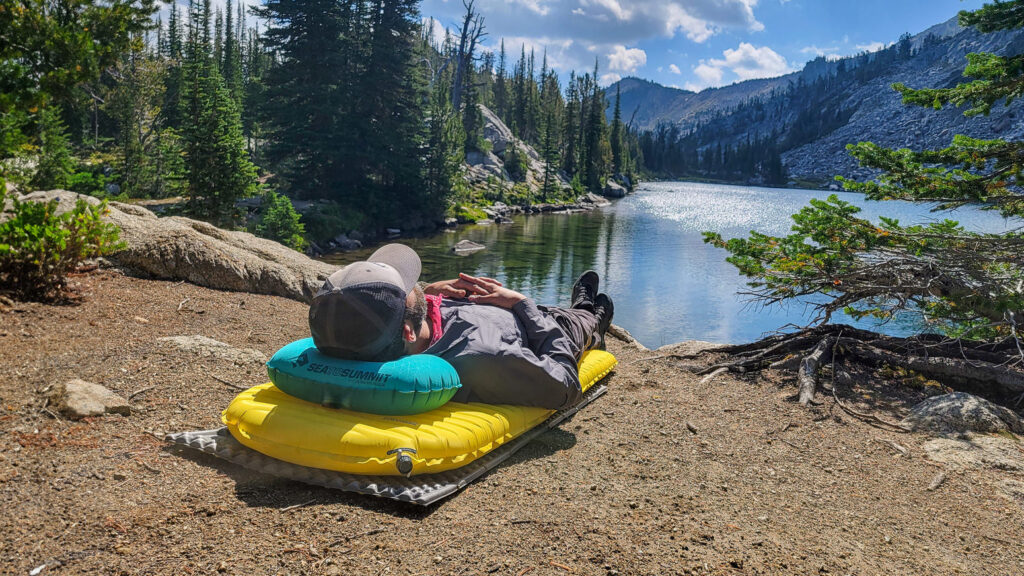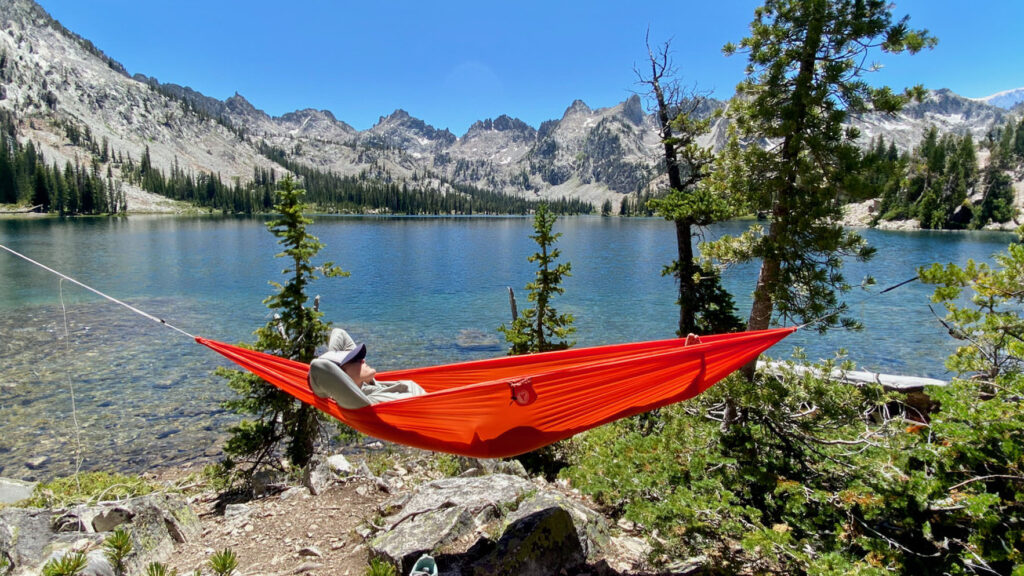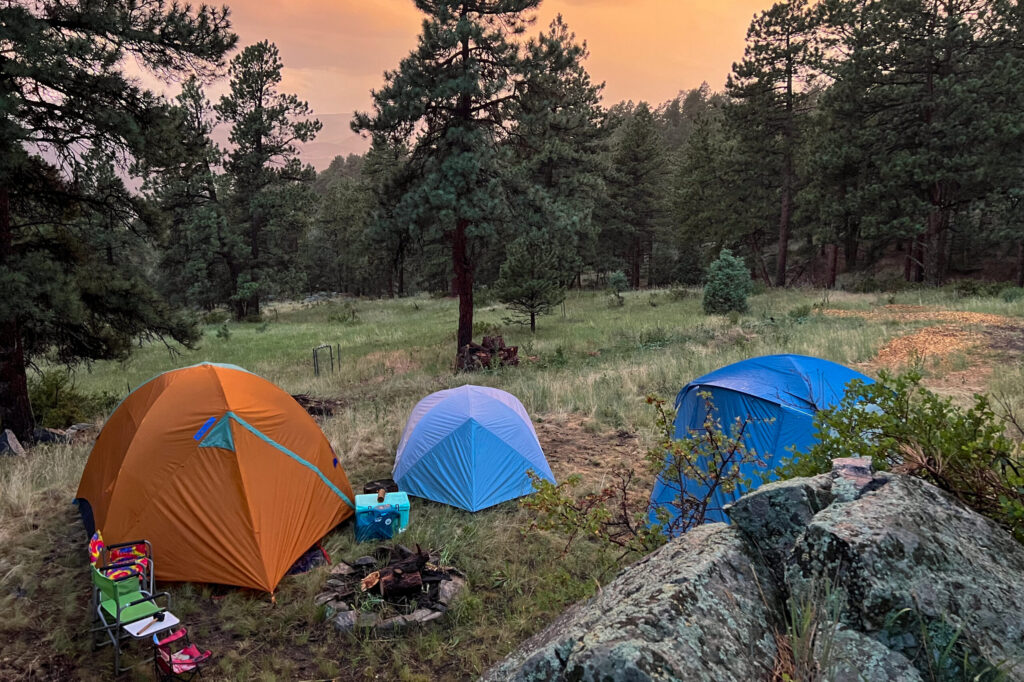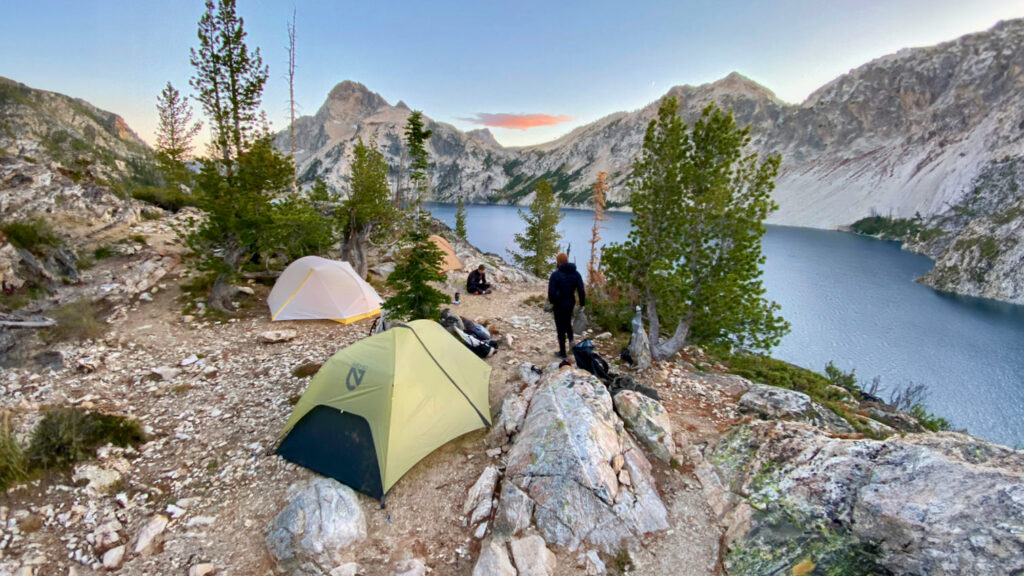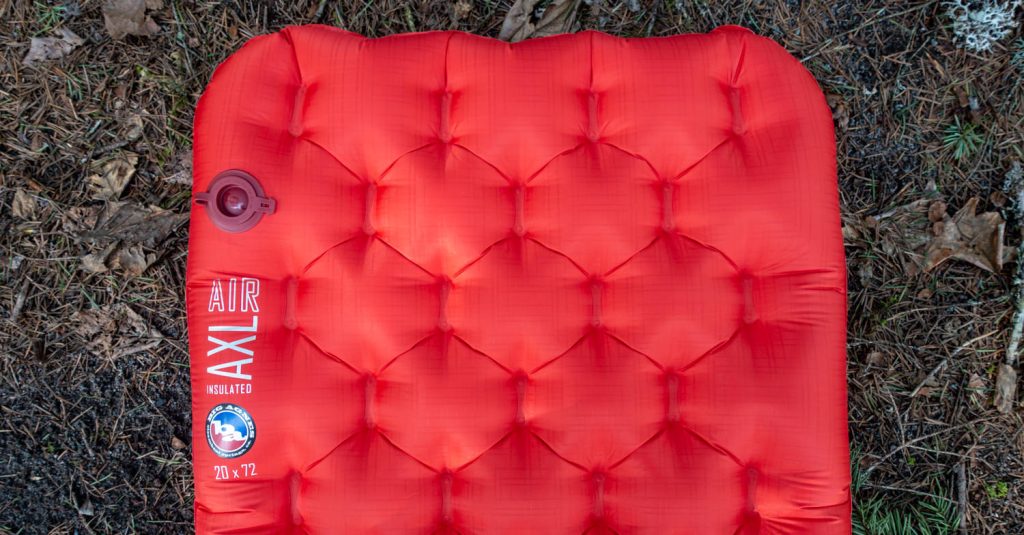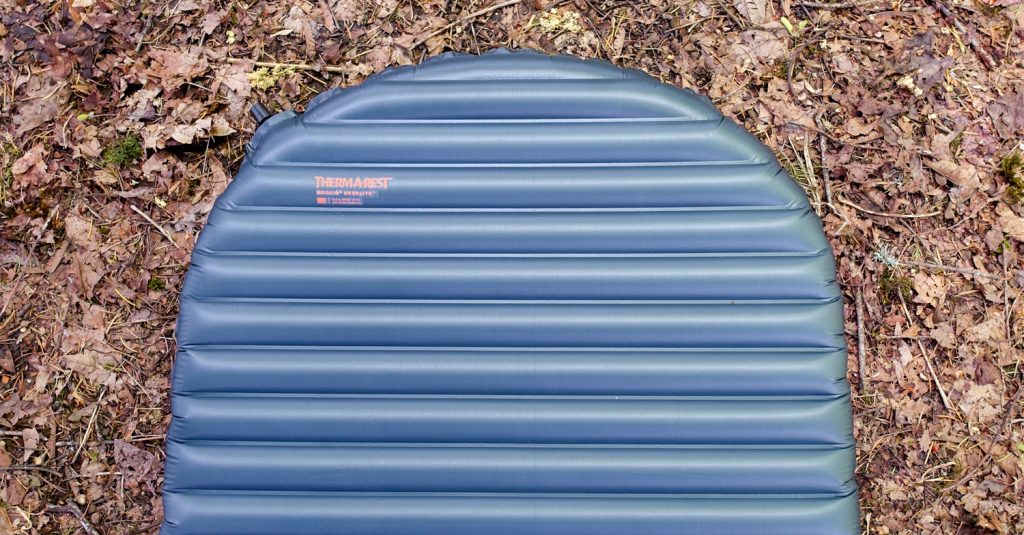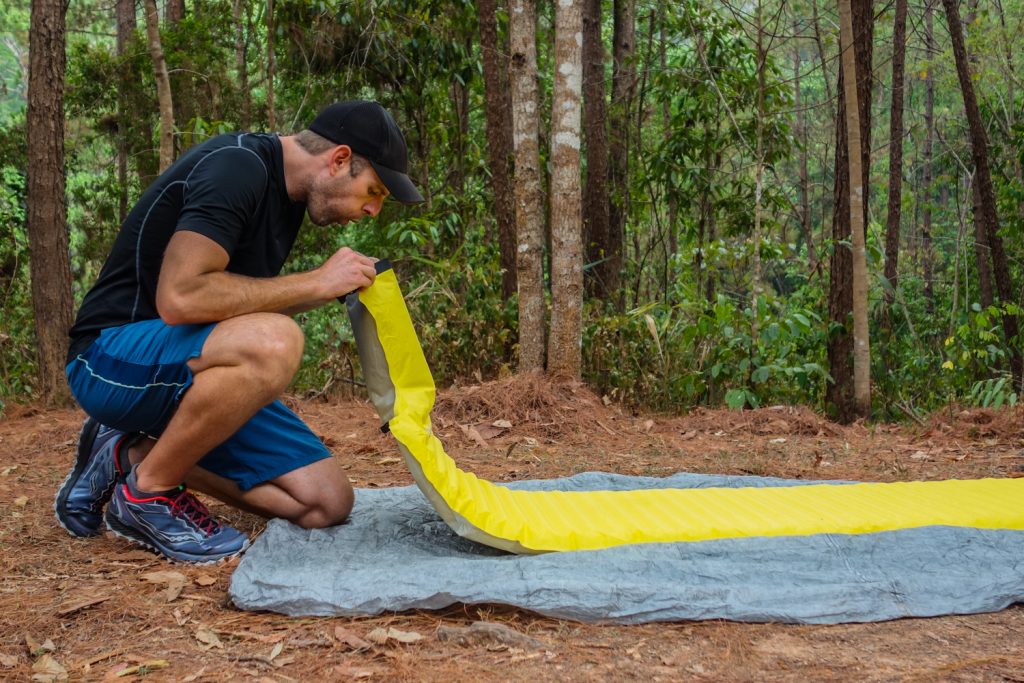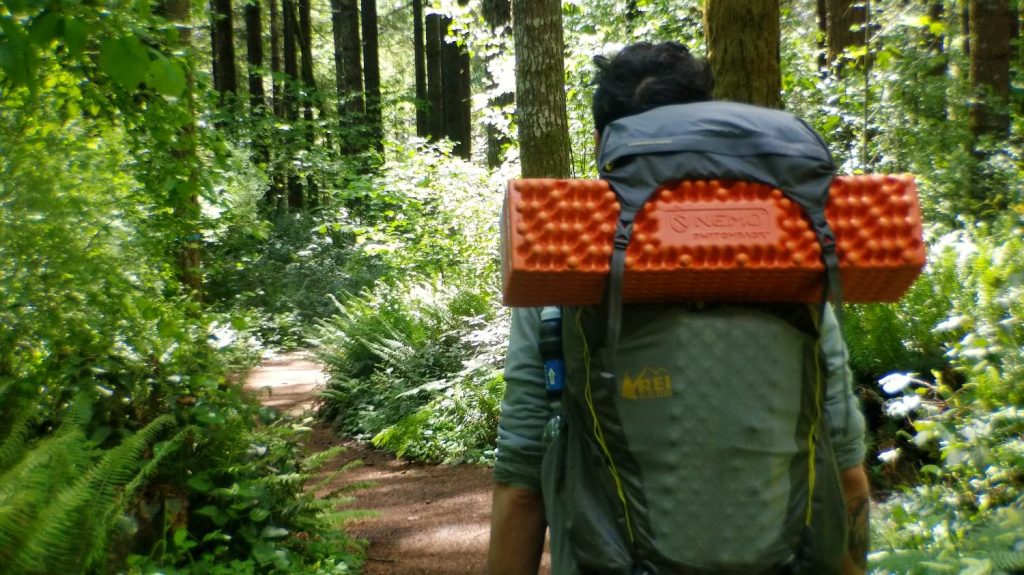
Bottom Line
If you’re a backpacker looking for an ultralight sleeping pad that’s as cushy as it is quiet, the NEMO Tensor Trail Ultralight Insulated is a solid choice. At 3.5 inches thick, this is one of the most comfortable backpacking pads for sleeping in any position – without sacrificing packability.
CleverHiker’s Casey Handley tested the Tensor Trail for over a month across 400 miles of the Arizona Trail, and she praised its easy inflation, solid durability, and reliable valve system that makes micro-adjustments easy. This pad is quiet, cushy, and convenient. It’s a clear winner for minimalist, ultralight backpackers and thru-hikers who want to sleep well under the stars.
However, the Tensor Trail has a fairly low R-value, so you’ll want to use it in mild and warm summer conditions. Its packed size is a tad longer than some inflatable backpacking pads, which can take up space in your backpack. And its extraordinary comfort comes at a slightly higher price than some budget pads. That said, its performance far exceeds its costs, making the Tensor Trail a top pick for long-distance hikers who want a great balance between weight and comfort.
Quick Specs
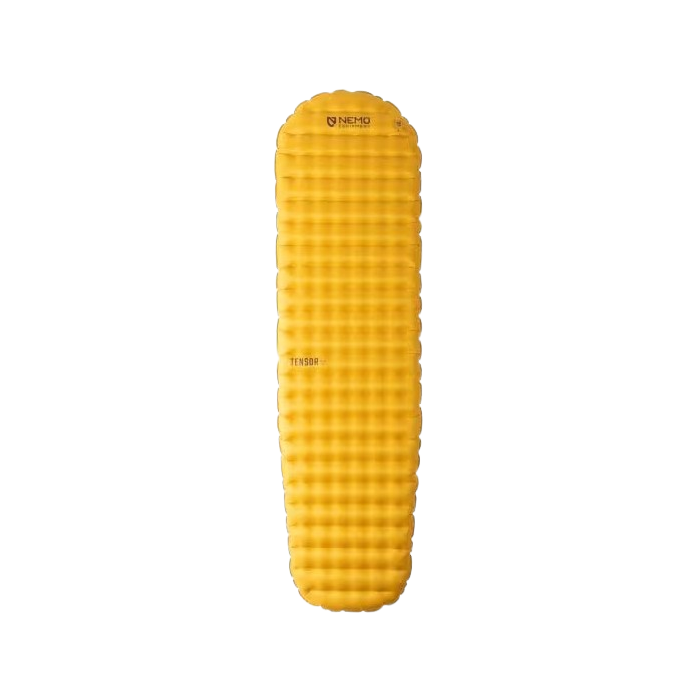
NEMO Tensor Trail Ultralight Insulated
Best Ultralight Rectangular Sleeping Pad
CleverHiker Rating: 75.3/100
Price: $180
Weight: 13 oz.
R-Value: 2.8
Thickness: 3.5 in.
Pros
- Ultralight
- Above-average comfort
- Exceptionally quiet
- Many size/shape options
- Quick inflation/deflation
- Very durable for the weight
- Comes with our favorite pump sack
Cons
- A bit expensive
- Not warm enough for sub-freezing temps
- Longer packed size
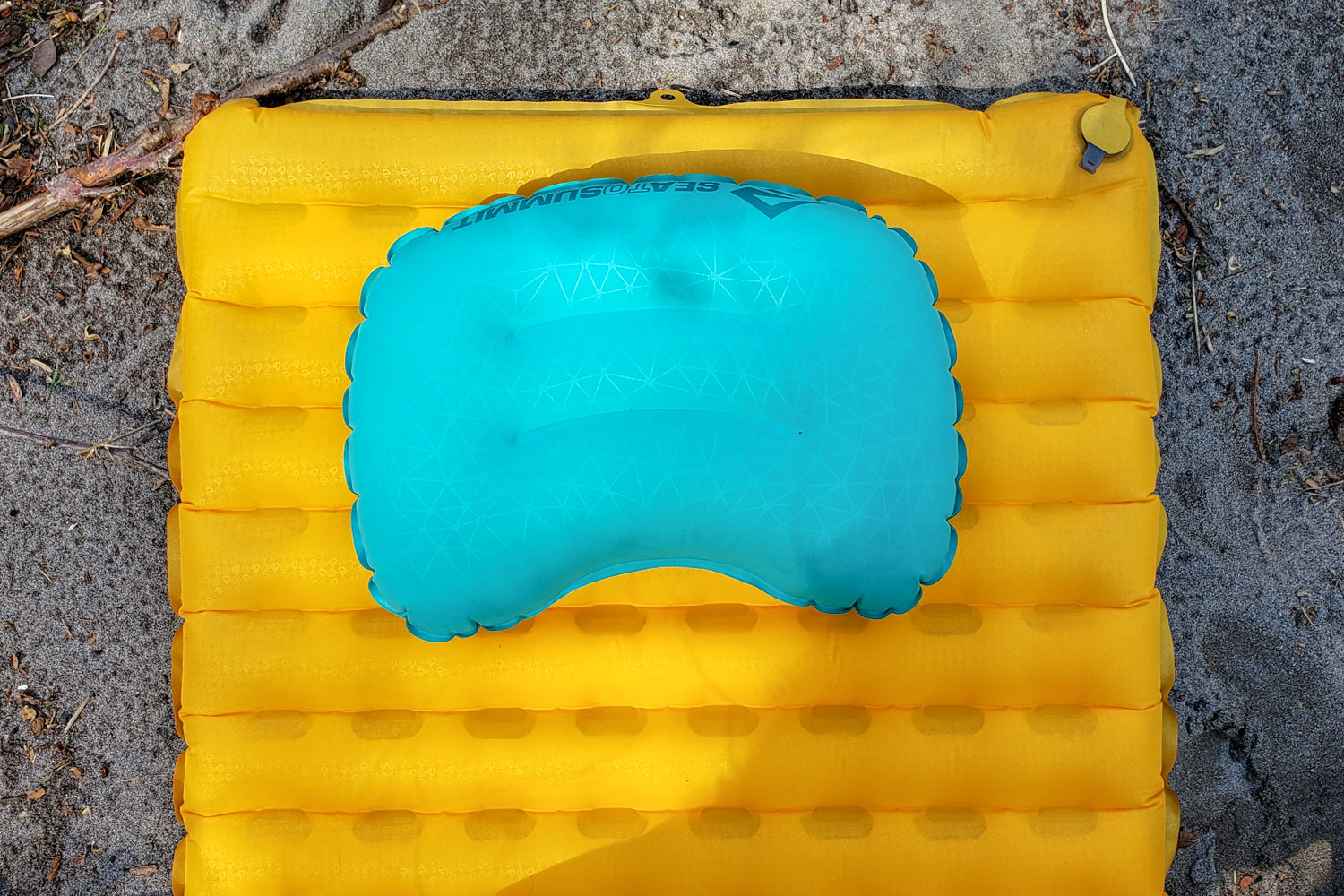
Comfort
The NEMO Tensor Trail Ultralight Insulated is one of the most comfortable ultralight pads on the market. It’s a cushy 3.5 inches thick, so you can dial in the perfect firmness, and there’s plenty of cushioning to accommodate any sleeping positions. That’s right side sleepers – no bottoming out! We also prefer thicker pads like the Trail Ultralight for camping on uneven and rocky ground since it’s harder to feel the bumps and lumps below.
This pad’s quilted pattern offers great support, and the 20D nylon on top has a soft, pleasant skin feel. Plus, it’s very quiet and avoids the crinkling noise of some pads that can disrupt sleep. Also, NEMO’s inclusive range of sizes caters to different body shapes with wide and long versions. It comes in a mummy format for the least weight, but you might like the rectangular design with more space to stretch out.
No pad is perfect for every occasion, including the Tensor Trail. The main limitation is that its R-value is on the low side, so this pad won’t be a good choice for chilly shoulder season spring and fall trips. If you’re looking for an equally awesome but warmer pad, check out the Tensor All-Season.
The other minor gripe we have is with the valve location. The inflation nozzle is nearly flush with the surface of the pad, but it’s located on the top corner of the sleeping pad instead of in the side seam. So, some of our stomach-sleeping testers could feel the valve occasionally when shifting around at night. Still, these are small complaints – when it comes to overall comfort, this pad is excellent.
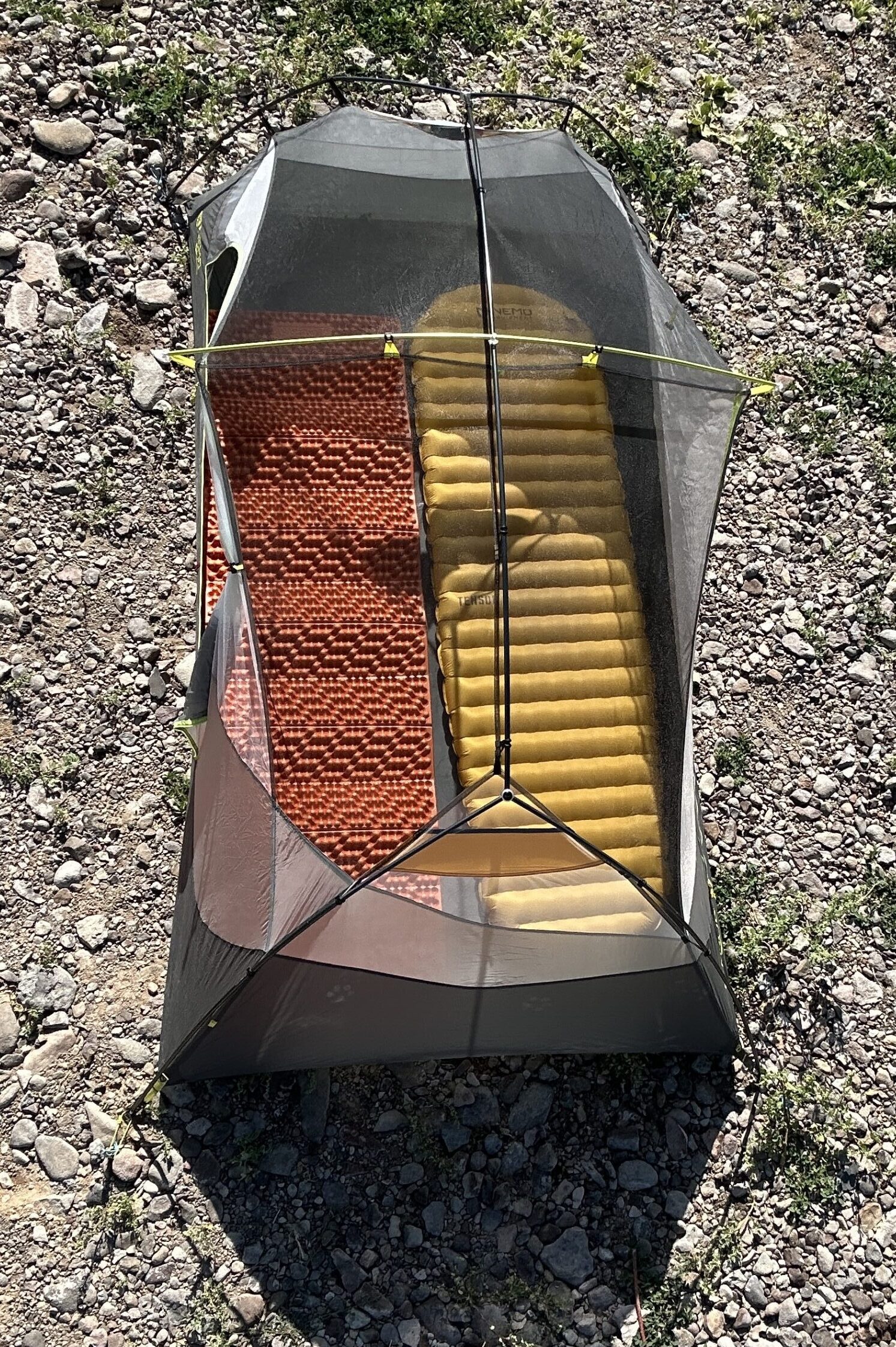
Weight & Packability
At only 13 ounces for the mummy version, the NEMO Tensor Trail is a great choice for ultralight backpacking. This pad is a good choice for anyone who wants to keep their overall pack weight down without sacrificing comfort or convenience.
High-quality materials and top-tier construction make this pad lightweight yet durable, with 20D and 40D nylon on the pad’s exterior that compresses well but unfolds easily. Thanks to a small packed size of 4 by 10 inches, it fits well in any backpack. NEMO’s innovative valve system makes this pad a breeze to set up and pack away: inflate the pad with a one-way valve and one of our favorite pump sacks in about a minute and pull the valve out to dump air in just seconds.
As with all ultralight gear, though, you’ll make some sacrifices. The Tensor Trail is very lightweight but not especially warm, so you’ll want to consider other sleeping pads when it’s below freezing. It packs down small, but 10 inches is a little longer than some sleeping pads and will take up a bit more space in your backpack. Also, the Tensor Trail has a higher price tag, which is typical for ultralight gear, so it’s not a great fit if you’re on a budget.
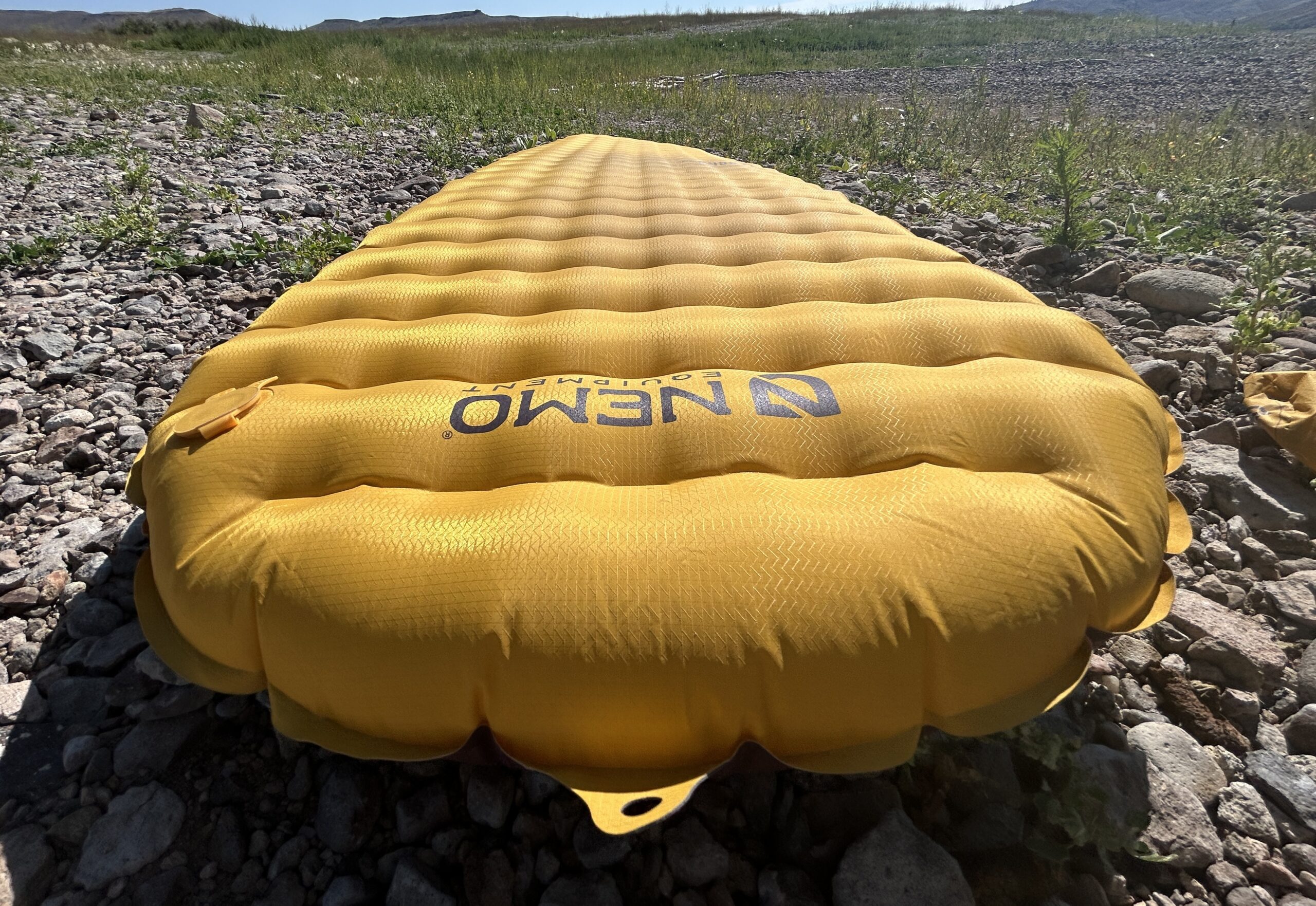
Warmth
The NEMO Tensor Trail offers decent warmth for its weight but works best on mild to moderate nights at 40°F and above. This is a great pad for summer backpacking adventures where weight and comfort are top priority.
With an R-value of 2.8, it’s insulated enough for late spring, summer, and early fall backpacking trips. Its 3.5-inch thickness is a respectable buffer between you and the ground, and the quilted pattern traps heat without adding unnecessary bulk or weight. The Tensor Trail’s 20D fabric on top is cooling to the touch on warm nights, and the 40D nylon on the bottom not only adds a bit of durability but some warmth as well.
However, this pad struggles to retain enough warmth when temperatures drop, and the Tensor Trail will feel uncomfortable below freezing. That means it’s not a good fit for folks who expect cold forecasts, like to camp at high altitudes or hike through shoulder seasons and snowy weather. Its ultralight construction is ideal for weight savings, but it lacks insulation in pads with higher R-values. Luckily, this model comes in a warmer version that we prefer for year-round use, called the Tensor All-Season – check out our full review of the Tensor All-Season here.

Ease of Use
The NEMO Tensor Trail is incredibly easy to set up thanks to a great pump sack, simple components, and top-tier materials. The included pump sack is one of our all-time favorites – it’s easy to fill with air, snaps onto the sleeping pad nozzle easily, and saves both breath and time. Plus, it only takes about a minute to inflate the large, 3.5-inch-thick pad.
The Tensor Trail’s zero-profile valve is one of the most user-friendly on the market. Its one-way valve lets air in for fast inflation and then pulls completely out to turn into a dump valve for mindless deflation. Its airtight seal prevents leaks and gradual deflation overnight and offers precise adjustments for the perfect firmness.
Its sturdy nylon fabric is strong but compressible, making it simple to unroll and lay flat quickly. The rectangular shape means there’s no fussing with orientation during setup. And it fits into the generous-sized stuff sack with room to spare, so you won’t have to wrestle it into place in the morning.
However, there are some minor drawbacks. The pump sack works well, but this pad takes longer to inflate by mouth because it’s got such a large internal volume, which can be a bit of a task at night after long miles. The pad’s valve placement – on top of the pad in the corner – might be noticeable for stomach sleepers who like to put their arms up by their heads. And we’ve also found the valve cover can be trickier to maneuver with cold or gloved hands. But all things considered, this is one of the best pads on the market for ease of use.
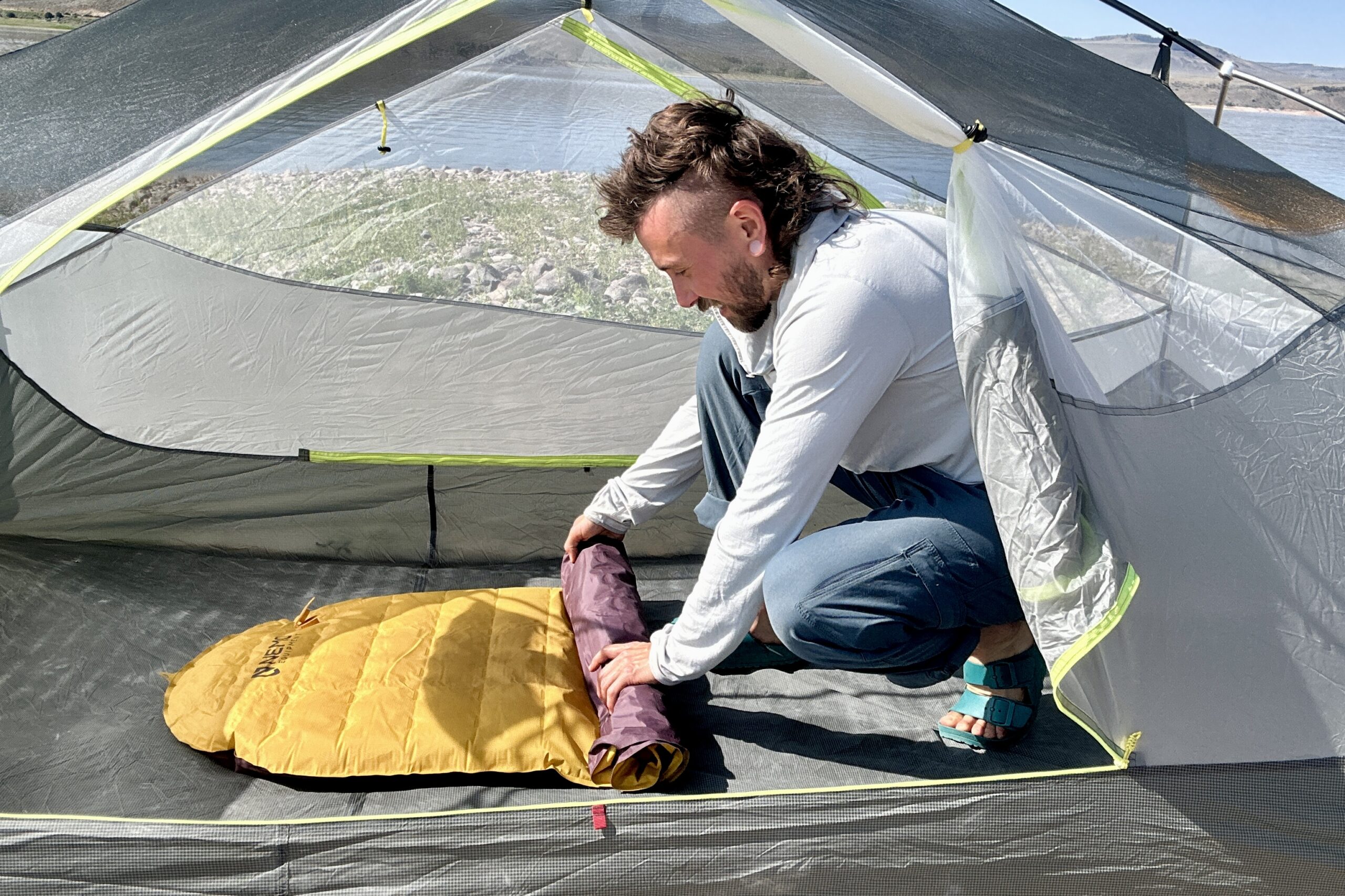
Durability
The Tensor Trail’s excellent engineering and thoughtful design make it a reliable sleeping pad for thousands of miles. Its durability is especially impressive considering its ultralight status, which typically means thinner, more fragile materials.
NEMO built the Tensor Trail with a robust yet lightweight 20D nylon on top and an even stronger 40D nylon fabric on the bottom to withstand wear from rough surfaces, abrasions, and frequent use. The valve system is excellent, too: it sits flush with the pad surface, so there’s no protruding nozzle asking to get damaged. The valve’s flexible plastic resists damage from thousands of inflation cycles without compromising performance.
This pad’s strong seams and burly insulation make it reliable for long adventures, but in case it does get damaged, NEMO also includes repair patches for field repairs.
That said, the Tensor Trail is still an ultralight pad. The nylon holds up well under regular use in most conditions, but it’s still not as puncture-resistant as some burly, higher-denier fabrics, and you’ll need to be cautious to avoid punctures from thorns, branches, and jagged rocks that could cause damage. It’s plenty durable for most summer backpacking trips, but it will also last longer if you treat it with care and clear your tent site of pokey objects before setting up for the night.
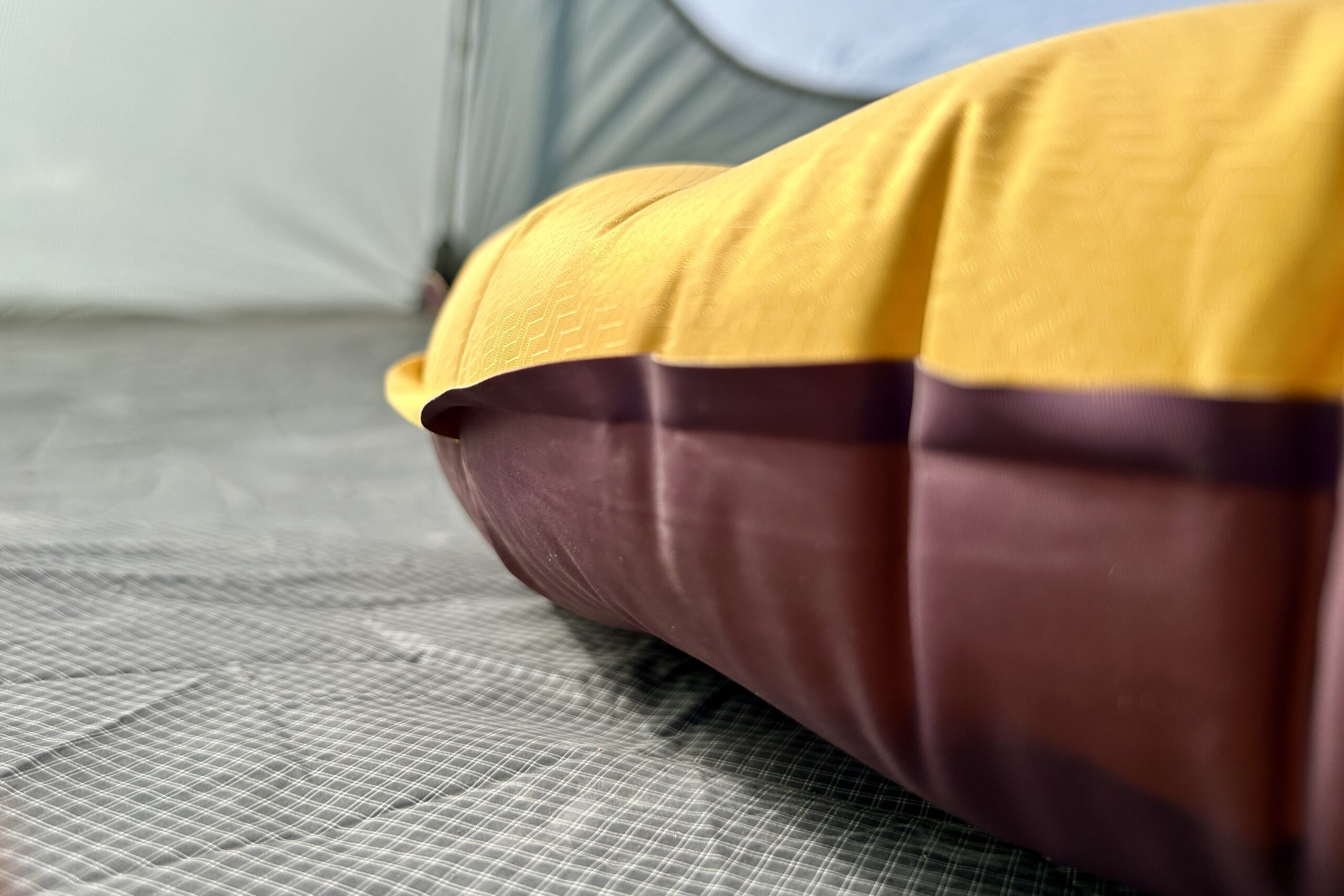
Should You Buy the NEMO Tensor Trail Ultralight Insulated?
The NEMO Tensor Trail Ultralight is a great option if you want an ultralight sleeping pad that doesn’t sacrifice comfort. It’s ideal for summer adventures where you want to maximize comfort – and with 3.5 inches of loft, supportive baffling, and inclusive sizing, catching Z’s is easy in the backcountry.
The Tensor Trail packs down small and weighs less than a pound, so whether you’re thru-hiking the PCT or staying local for the weekend, it’s easy to carry day after day. Backpackers who want fast inflation and deflation will love the Tensor’s pump sack and efficient valve. This is one of the most convenient sleeping pads we’ve ever tested.
However, this pad isn’t the best fit for cold weather – its lower R-value makes it more suitable for backpackers who mostly hit the trail in summer weather. The Tensor Trail also packs a little bulkier than some pads, so it might miss the mark if you’re looking for the most compact pad possible. Also, its higher price point might deter budget-conscious buyers. But if you’re after a cushy, supportive, and very convenient sleeping pad, the NEMO Tensor Trail is a solid choice.
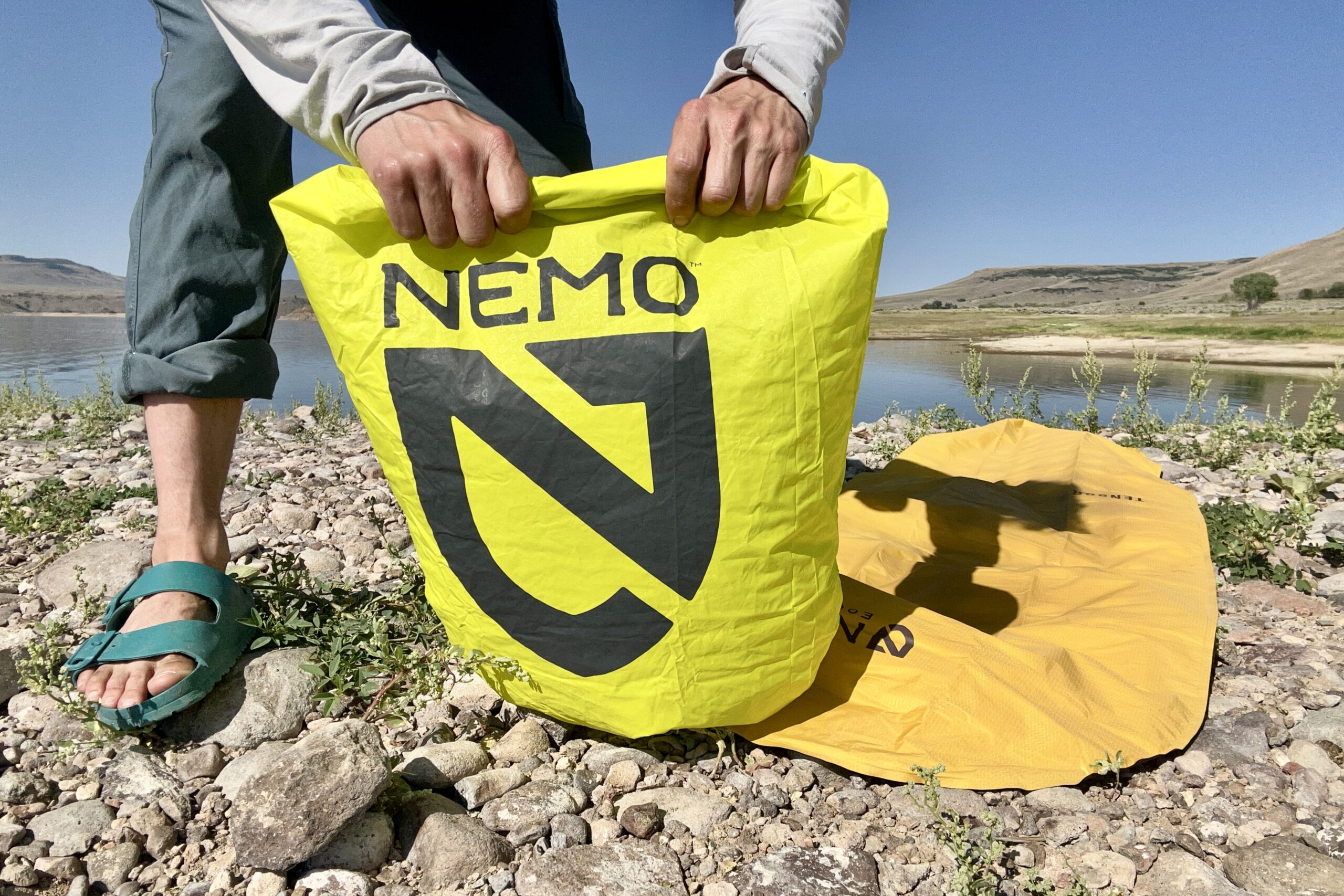
What Other Backpacking Pads Should You Consider?
Check out our complete list of the Best Backpacking Sleeping Pads for all our top recommendations.
NEMO Tensor All-Season Review: This is the more insulated version of the Tensor Trail Ultralight. Thanks to its above-average R-value, it’s nearly two times warmer, so it can be used from summer through winter. The Tensor All-Season is a little pricier and a tad heavier, but it offers the same packed size, comfort, and convenience. In general, we prefer the versatility and warmth of the All-Season, but both pads are great options.
Therm-a-Rest NeoAir XLite NXT Review: The Tensor Trail and XLite NXT weigh the same in the regular mummy size, but the XLite has a much higher R-value. That makes the XLite a more versatile pad that you can use in much colder temps. The XLite does cost a bit more, and it isn’t quite as convenient as the Tensor Trail, but it’s one of our top choices for ultralight backpackers.
Big Agnes Zoom UL Review: The Big Agnes Zoom UL scores similar marks as the Tensor Trail Ultralight when it comes to weight, comfort, and price – but this model stands out for its superior warmth. With an R-value of 4.3 – that’s 1.5 points higher – the Zoom UL is a better choice for colder temps. It’s a bit slower to set up and not quite as thick or durable, but this pad is preferable for staying warm on shoulder season camping trips.
Sea To Summit Ether Light XT Insulated Review: This pad matches the Tensor Trail Ultralight in warmth, durability, and ease of setup. But for those who want even more plush comfort in the backcountry, this pad is 4 inches thick – though it’s heavier and costs more.


